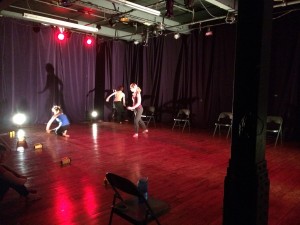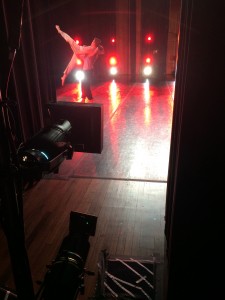If you have ever wanted to be a part of a fringe festival, this piece is for you. Get some of the details before you sign on to make the process easier, and hopefully, more enjoyable!
by Katie C. Sopoci Drake
1. Read the fine print
Fringe shows have a lot of rules and fine print. A lot. Some require you to have a website, some require you to have their branding on your advertisement, and all have a lot of very specific deadlines. Read it all and make a checklist. You don’t want to show up at the theater the day of your tech to find out that not only did you have to provide your own lighting designer, but the space is 20×16 and there are no wings.

2. Snazzy Postcards
Everyone has a postcard and you need one too. Here’s the catch, you must make yours stand out without breaking the bank. Funky sizes, color and gloss do this, but they all cost extra. First, figure out what image will instantly scream, “This is the vital essence of my show!” and then pick one of the “extras” that will make your postcard stand out from the others and enhance the message of your advertisement. You will be handing these out like candy, so skip the D.I.Y., “Each of these cards are like a special flower” treatment because people WILL grab them, fold them, shove them in a pocket, or throw them in the trash in front of your eyes.
3. Edit your show description for a non-dance crowd
You know what your piece is about, your dancers get it, but the bad news is that unless you write your title and description to scream, “This is a dance, it is about ____, it the general feel is ____, and it appeals to the ____ crowd!”, then no one but your family and those 3 local die-hard dance fans will come. Stay away from vague and florid language. Keep it short and spell out what the audience will see in as few words as possible.
Here’s a sweet little guide to writing a good Fringe description: http://vicfringeartists.webs.com/apps/blog/entries/show/10703899-fringe-tutorial-1-crafting-a-good-show-description
4. Edit your show for a Fringe audience
Fringe shows are a beast of their own. Fringe audiences are a fun crowd for a reason. They expect a little bit of disaster (intentional or not) with their show-going experience. Because the list of Fringe shows is a mile long, many of your fellow artists will put out their most experimental, bawdy, or hilarious material to get noticed. You will see shows that just don’t fly in a traditional setting here because part of the fun is seeing shows that don’t fit neatly into a regular season. Clowning, one-man/woman shows, and brash political/social commentary all have a welcome home at the Fringe. Knowing what your show will be surrounded by might help you either choose a theme, or a piece from your repertoire that will feel at home too. Comb through show descriptions and reviews from years past to get an idea of what to expect.

5. Shows have 1 or 2 performers for a reason
You read the fine print. Unless you write your own material, dance it yourself, make your own costumes, etc., you will not be able to recoup the price of your rehearsal space rentals in ticket sales. You can’t afford to pay multiple dancers, designers, and rights for text or music. You cannot. So keep it simple, everyone else is too.
Side note: if you are traveling, most Fringe performers stay with friends or local artists near their venue and go grocery shopping for their food. Keep those costs down and get some good friend-time in, but warn your hosts that Fringe-ing will mean late nights and sleeping in.
6. Time your show down to the minute and practice your load in and load out
Fringe shows are often back-to-back in the theaters. It’s one way to keep the venue costs down and the crowds coming. Some festivals will have very specific rules about load-in and load-out and you may only get access to the theater (and its limited dressing room space) for 10-15 minutes before and after your show. So if you have lots of costumes, props, and people, you need to develop a neat little system of transportation down to who is in charge of what rolling suitcase and who is carpooling with whom who will have room in their vehicle for said suitcase. Read the fine print in the Fringe material and talk to your venue about storage options for your stuff.
7. Social Media Cross-Posting. Duh.
Everything about your digital life is going to need to be about the Fringe and link to the official Fringe website where people can buy official tickets. Every Fringe has different rules (buttons, passes, tickets, etc.) and you don’t want to confuse your potential digital audience. Always include a ticket link, Make sure you are using just one image to advertise yourself, and post often. If someone picks up your Fringe postcard and hops on your website to see if you’re worth seeing, you want to provide them with easy identification and a link to buy tickets. Quick! Before they change their mind!
8. Court the press
Most Fringe festivals send press to the shows at least once. If you’re lucky enough to catch them before they dash out the door, talk to the press, thank them for coming (yours is probably the 8th show they’ve seen that day) find out a bit about them and give them a little personal information in exchange. They may be a theater reviewer seeing dance for the first time and you may be able to unlock the mystery that is non-narrative/non-linear composition. It’s worth a shot. Also, be aware that there a host of bloggers out there. Hunt them down online or at the after-parties (see below) and invite them to your show. These hearty individuals will sometimes have a cult Fringe following and can drive more traffic to your show than a well chosen postcard image can hope to glean.
One of the Minnesota Fringe’s most avid supporters: http://purplesquirrel.livejournal.com/
9. See every dance show, use all of the discounts, and hit every after-party
See as many other shows as you can (without burning out), eat at all of the restaurants that give you a Fringe discount, and then meet the artists after the show or at the after-party. This is the best part of the Fringe. Most Fringe festivals have a nightly party after the day’s shows are done. Go to all of these. This is where you will meet other artists, share show information, exchange postcards AND… convince other artists to mention your show in their curtain speech. This is one of the best tools of the serial Fringer. If you spot a show that is similar to yours, chances are that their audience will be interested in your show too.
– Tell them what you liked about their show.
– Invite them to your next show and tell them why they should actually show up.
– Promise to recommend their show in your curtain speech, and then get them to do you a solid and mention yours. Most artists will happily spread the good word about other dance shows.
10. Think about next year…
You may want to do the Fringe again, or try expanding your Fringe tour to other cities. Well, good news! The Fringe you’re in is chock full of experienced Fringers who will be more than happy to tell you which Fringes are worth your money and which ones are a rip-off. Gather that info and take heed: not all Fringes are created equal.
______________________________

Photo by Scott Pakudaitis
Contributor Katie C. Sopoci Drake, MFA, GL-CMA, is a Washington D.C. based professional dancer, choreographer and teacher specializing in Laban-based contemporary dance. Holding an MFA in Dance from the University of Wisconsin-Milwaukee, a Graduate Certification in Laban Movement Analysis from Columbia College – Chicago, and a BA in Theatre/Dance with a minor in Vocal Performance from Luther College, Sopoci Drake continues to take classes in as many techniques and practices as she can handle to inform her work and life as a curious mover.
Katie has been on faculty at The University of Wisconsin-Milwaukee, Nova Southeastern University, Miami Dade College-Wolfson, Miami Dade College-Kendall, Carthage College, and Lawrence University. She currently guest teaches and gives masterclasses around the D.C. area and wherever her travels take her.
As a performer, Sopoci is described as a “sinuous, animal presence of great power; watching her dance is a visceral experience.” (Third Coast Digest). Company credits include Mordine and Company Dance Theater of Chicago, Momentum Dance Company of Miami, Wild Space Dance Company of Milwaukee, and Rosy Simas Danse of Minneapolis. Katie has also made appearances an an independent artist with many companies including Brazz Dance, Your Mother Dances, The Florentine Opera, and The Minnesota Opera.
Katie’s choreography, described as “a beautiful marriage between choreography, music and poetry” (On Milwaukee), arises from her fascination with the idiosyncrasies of daily life, and the flights of fancy that arise from ordinary inspirations. Her work has been performed by numerous companies, colleges and studios across the country and her latest collaboration, Telephone Dance Project, will take her to states up and down the East Coast while investigating long-distance creation and connecting far-flung dance communities.




